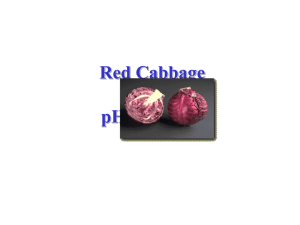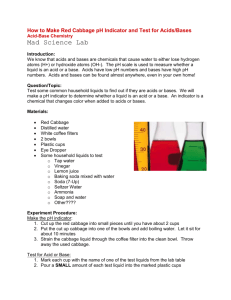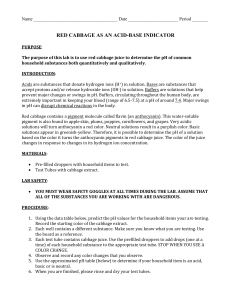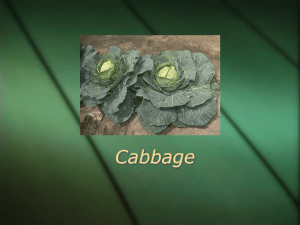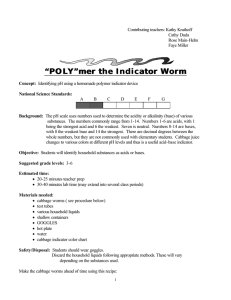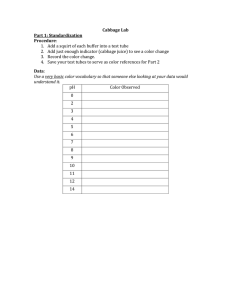DETERMINING pH WITH RED CABBAGE PAPER
advertisement
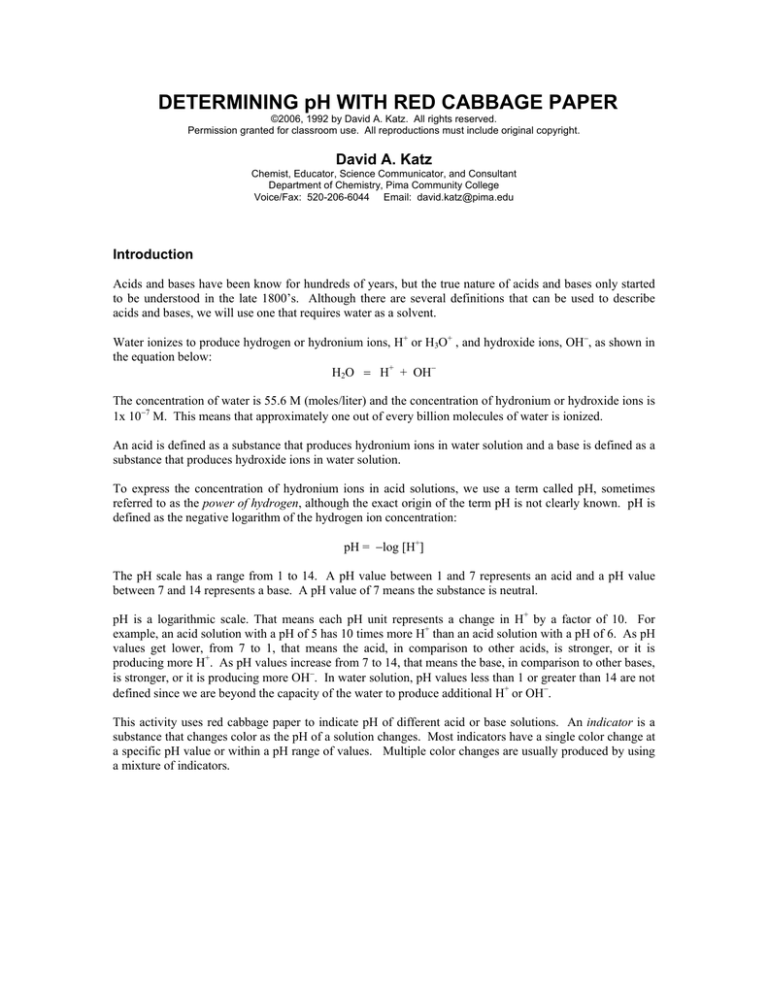
DETERMINING pH WITH RED CABBAGE PAPER ©2006, 1992 by David A. Katz. All rights reserved. Permission granted for classroom use. All reproductions must include original copyright. David A. Katz Chemist, Educator, Science Communicator, and Consultant Department of Chemistry, Pima Community College Voice/Fax: 520-206-6044 Email: david.katz@pima.edu Introduction Acids and bases have been know for hundreds of years, but the true nature of acids and bases only started to be understood in the late 1800’s. Although there are several definitions that can be used to describe acids and bases, we will use one that requires water as a solvent. Water ionizes to produce hydrogen or hydronium ions, H+ or H3O+ , and hydroxide ions, OH−, as shown in the equation below: H2O = H+ + OH− The concentration of water is 55.6 M (moles/liter) and the concentration of hydronium or hydroxide ions is 1x 10−7 M. This means that approximately one out of every billion molecules of water is ionized. An acid is defined as a substance that produces hydronium ions in water solution and a base is defined as a substance that produces hydroxide ions in water solution. To express the concentration of hydronium ions in acid solutions, we use a term called pH, sometimes referred to as the power of hydrogen, although the exact origin of the term pH is not clearly known. pH is defined as the negative logarithm of the hydrogen ion concentration: pH = −log [H+] The pH scale has a range from 1 to 14. A pH value between 1 and 7 represents an acid and a pH value between 7 and 14 represents a base. A pH value of 7 means the substance is neutral. pH is a logarithmic scale. That means each pH unit represents a change in H+ by a factor of 10. For example, an acid solution with a pH of 5 has 10 times more H+ than an acid solution with a pH of 6. As pH values get lower, from 7 to 1, that means the acid, in comparison to other acids, is stronger, or it is producing more H+. As pH values increase from 7 to 14, that means the base, in comparison to other bases, is stronger, or it is producing more OH−. In water solution, pH values less than 1 or greater than 14 are not defined since we are beyond the capacity of the water to produce additional H+ or OH−. This activity uses red cabbage paper to indicate pH of different acid or base solutions. An indicator is a substance that changes color as the pH of a solution changes. Most indicators have a single color change at a specific pH value or within a pH range of values. Multiple color changes are usually produced by using a mixture of indicators. Taste an acid / Taste a base One means of identifying acid and base substance is be taste. Although it is strongly advised never to taste any laboratory chemicals, this procedure can be carried out using household materials in dilute solutions, provide all safety precautions are followed. Safety Precautions This activity must be performed in a clean, contamination free area, away from laboratory chemicals. All materials used must be food grade or better and should be newly purchased. If stored, they must be stored away from any possible source or contamination, preferably at home. Materials needed 2 pitchers (plastic preferred). One pitcher should be labeled “ACID” and one pitcher labeled “BASE” sour salt (citric acid) solution in ACID pitcher baking soda (sodium bicarbonate) solution in BASE pitcher 3 ounce drinking cups Procedure The ACID pitcher contains a solution of sour salt (citric acid). Pour about 5 to 10 mL of the acid solution into a clean paper cup. The BASE pitcher contains a solution of baking soda (sodium bicarbonate). Pour about 5 to 10 mL of the base solution into a clean paper cup. SIP a SMALL AMOUNT of the ACID solution. Describe the taste. (If necessary, you may take a second taste of the solution. DO NOT drink all the solution.) SIP a SMALL AMOUNT of the BASE solution. Describe the taste. (If necessary, you may take a second taste of the solution. DO NOT drink all the solution.) Discard any remaining solutions and the paper cups. Determining the pH of Household Materials using Red Cabbage Paper Materials needed Red cabbage paper (The red cabbage paper was prepared previous to this class. For your information, see procedure for preparing red cabbage paper) Buffer solutions. Note: pH values of 1, 2, 4, 6, 7, 8, 10, 12, and 14 are recommended. Stirring rods (plastic coffee stirrers) Small beakers or 3 oz plastic cups Pen or pencil Household materials such as soap, laundry detergent, shampoo, baking soda, vinegar, lemon juice, vitamin C tablets, toothpaste, soda, etc. Procedure 1. How to make red cabbage paper Note: This procedure is not necessary if red cabbage paper was prepared in advance for your class. Place pieces of red cabbage in a blender with ethyl rubbing alcohol (70% ethyl alcohol in water) or a 50% mixture of denatured alcohol with water. DO NOT FILL BLENDER JAR MORE THAN 1/3 FULL. Blend until smooth. Strain the liquid through several layers of cheesecloth. Safety Note: Ethyl alcohol is flammable. Keep it away from flames. Do not fill the blender more than one-third full to avoid splashing any alcohol from the blender. Sparks from the blender motor can ignite any spilled or splashed alcohol. Obtain filter paper circles or coffee filter circles. Dip in the red cabbage juice. Lay out in a single layer on clean table tops, or tables covered with clean plastic, to dry. Store in a Ziploc type bag in a cool dark place. The red cabbage paper will keep for 6 months or longer with no odor or spoilage. Alternative Procedure If the alcohol is not available, place pieces of red cabbage in a blender with some water. Blend to produce a thick slurry. Pour the red cabbage mixture into a large pot or beaker and heat to boiling. (This kills most of the bacteria that causes the red cabbage to spoil.) Strain the mixture through cheesecloth into a clean container. Discard the solids. Allow the liquid to cool. Soak filter paper circles in the red cabbage liquid. Place the filter paper circles in a single layer on a clean table top and allow them to dry completely. This will take several hours or they can be left overnight. Place the dried red cabbage paper in a plastic bag. Store in a cool place, away from bright light. The paper keeps for at least 6 months. 2. Prepare a color chart of pH colors Obtain a piece of red cabbage paper. Note the pH solutions and buffers that are available for the experiment. (Note: pH is a measure used to compare the strengths of acids and bases. Buffers are solutions that are made to maintain a constant pH for reference purposes.) Using a pencil, or pen, label the red cabbage paper with the pH's of the available pH solutions and buffers similar to the diagram in figure 1. Using the stirring rods, or droppers, in the individual pH and buffer solutions, place one drop of each solution on the red cabbage paper next to the proper label. (For example, put a drop of pH 1 buffer next to the pH 1 label on the paper.) What results do you observe after placing the spots of the solutions on the red cabbage paper? Figure 1. A labeled sheet of red cabbage paper. 3. Test household materials There are solutions of common household materials in the laboratory. Use the stirring rods from each solution to place a drop on an open space on the red cabbage paper. Label each spot with the identity of the household material used. What pH values do different types of household substances have? (Complete the following table. Note: There may be more spaces than the number of substances available in the laboratory. ) Household product pH ______________________________________ ________ ______________________________________ ________ ______________________________________ ________ ______________________________________ ________ ______________________________________ ________ ______________________________________ ________ ______________________________________ ________ ______________________________________ ________ ______________________________________ ________ ______________________________________ ________ ______________________________________ ________ ______________________________________ ________ ______________________________________ ________ ______________________________________ ________ ______________________________________ ________ ______________________________________ ________ ______________________________________ ________ ______________________________________ ________ ______________________________________ ________ ______________________________________ ________ ______________________________________ ________ ______________________________________ ________ ______________________________________ ________ Questions Which substances you tested are acids? Which substances you tested are bases? Can you determine any patterns of pH values with certain types of household products? What does “pH balanced” mean in some household products?
